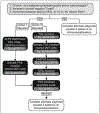Autoimmune Lymphoproliferative Syndrome: An Overview
- PMID: 30958694
- PMCID: PMC10415410
- DOI: 10.5858/arpa.2018-0190-RS
Autoimmune Lymphoproliferative Syndrome: An Overview
Abstract
Autoimmune lymphoproliferative syndrome (ALPS) is an inherited nonmalignant lymphoproliferative disorder characterized by heterozygous mutations within the first apoptosis signal receptor (FAS) signaling pathway. Defects in FAS-mediated apoptosis cause an expansion and accumulation of autoreactive CD4- and CD8- (double-negative) T cells, leading to cytopenias, splenomegaly, lymphadenopathy, autoimmune disorders, and a greatly increased lifetime risk of lymphoma. The differential diagnosis of ALPS includes infection, other inherited immunodeficiency disorders, primary and secondary autoimmune syndromes, and lymphoma. The most consistent pathologic feature is a florid paracortical expansion of double-negative T cells in lymph nodes. A presumptive clinical diagnosis can be made from symptoms and a constellation of laboratory test results. However, a definitive diagnosis requires ancillary testing and enables disease subclassification. Recognition of ALPS is critical, as treatment with immunosuppressive therapies can effectively reduce or ameliorate symptoms for most patients.
Figures




References
Publication types
MeSH terms
Grants and funding
LinkOut - more resources
Full Text Sources
Research Materials
Miscellaneous

